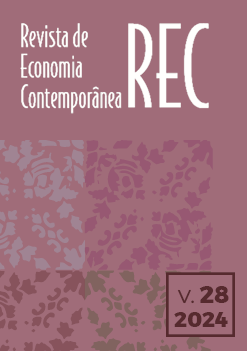Real wage and distributive conflict of Brazilian: economy from 2010 to 2019
Keywords:
Nominal wages, Money prices, Real wage, Profit margins, National accounts system, Multisector approachAbstract
This work analyzes the evolution of distributive conflict in the Brazilian economy from 2010 to 2019, based on the understanding that in an open economy, there are two price-setting methods: one that follows domestic pricing and another following international reference values. To do so, we calculated the price index for Brazilian and global exports and classified sectors according to the price-setting method employed (into domestically-priced and internationally-priced sectors). Then we analyzed the behavior of their respective distributive variables. Divided into two phases, the analysis period covers 2010-2014 when the inflation rate is slightly higher but doesn’t prevent real wage and unit labor growth and profit margins decrease, and 2014-2019, when the inflation rate decreases simultaneously to a fall in real wages, unit labor cost, and profit margins of internationally-priced sectors.
Downloads
Downloads
Published
Issue
Section
License
Copyright (c) 2024 Leandro Gomes

This work is licensed under a Creative Commons Attribution 4.0 International License.


